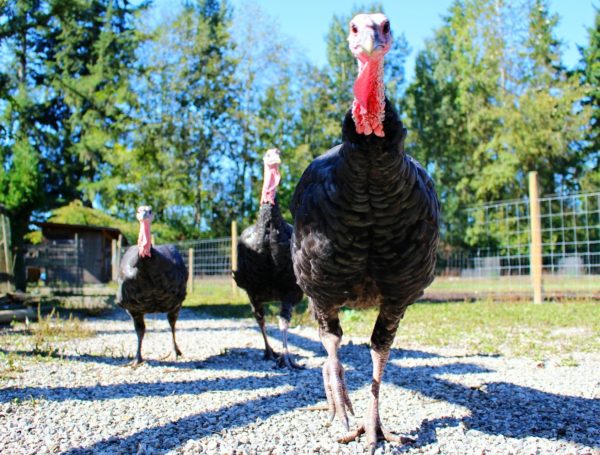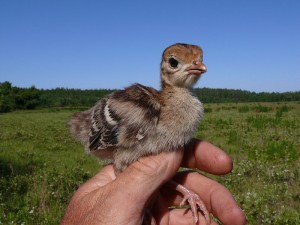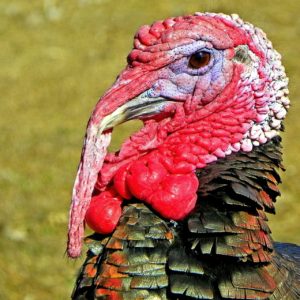When Wild Turkey numbers dwindled in the twentieth century from hunting and habitat loss, various states, such as California, adopted programs to reintroduce them. These programs have saved them from extinction. Today, wild turkey populations have recovered throughout the United States.

Here in Northern California, wild turkeys are a daily occurrence. You’ll find them roaming free in suburban front yards and public parks. Drivers routinely stop for a pack of turkeys to cross a busy street. The gang will stroll across the street without concern, fanning their tail feathers and pecking at bits of leaves while crossing.
Although most people take delight in seeing wild turkeys prosper, the turkey remains the meat du jour for Thanksgiving in America and Canada. In the spirit of the Thanksgiving holiday, we’d like to share a few fascinating facts about the turkey – both wild and domestic. Then, when the family gathers around the table and rambles on about politics, you can steer the discussion to turkey talk.
Interesting Facts about Turkeys
- Wild Turkeys live for about four years. They are affectionate, highly social, and form long-lasting bonds. They travel in groups and can recognize each other by their voices. Sadly, factory-raised domestic turkeys are killed when they are a few months old. They don’t have the opportunity to form social bonds or be playful. Most of these turkeys are barely kept alive during their short life span. The ammonia-filled structures and unsanitary conditions cause the turkeys to develop respiratory disorders, skin lesions, and burned eyes. They are given antibiotics so they can survive until it’s time for their slaughter.
- Wild Turkeys sleep together in trees. Turkeys fly into trees in the evening and perch on tree branches to stay safe from predators, such as coyotes and foxes. When they wake up in the morning, they call out a series of soft yelps before descending the trees to make sure the others in the roosting group made it through the night okay. During the day, turkeys communicate with each other by chattering. They also whistle to locate lost flock members. Studies have identified more than 28 different vocalizations.
- Wild Turkeys are omnivorous foragers and eat a varied diet of seeds, berries, grass, and insects. On the contrary, commercially raised turkeys are fed corn and soy with growth enhancers* to make them gain weight quickly. Because commercially farmed turkeys live in an impoverished environment where they can’t forage, this instinct is re-directed to feather pecking. To reduce feather pecking, these turkeys are beak-trimmed.
*Growth-inducing antibiotics are used instead of growth hormones; the FDA prohibits hormone use in poultry. Recently, the FDA has asked producers to discontinue using growth-inducing antibiotics due to the growing problem of antimicrobial resistance in humans.
- Wild Turkeys chew food with their stomach. Turkeys have two stomachs. The first stomach is called the glandular stomach, where food is softened and broken down by gastric juices. The turkey’s second stomach, the gizzard, contains stones eaten by the turkey. Turkeys must eat stones to grind food since they do not have teeth.
- Wild Turkeys can fly up to 55 mph for short distances and run 15-30 mph. When scared, they are more likely to run. On the contrary, commercially farmed turkeys are not able to fly or run because they’ve been genetically manipulated to grow enormous breasts for white meat production. This, along with their high carbohydrate diet, causes an abnormally large body weight, which makes it impossible to fly or run.
- Wild male turkeys are colorful. Males display their elaborate iridescent feathers, ranging in colors of bronze, copper, red, and green, during courtship. People who purchase commercially raised turkey (from a grocery store) are not buying the colorful turkey found in the wild. Factory-farmed turkeys are selectively bred to have white feathers, so their skin is not discolored by the dark feathers.
- When it comes to mating, snood size matters. Male turkeys have a flap of flesh that hangs over their
 beak called a “‘snood” and the fleshy growth under the turkey’s throat is called a “wattle.” These pieces fill up with blood and turn bright red when a male wants to attract a hen. Female turkeys prefer to mate with males with longer snoods. Snood length is associated with male turkey health. Males with a longer snood are less likely to harbor the intestinal coccidia, a protozoan parasite that causes infection. On factory farms, male turkeys are de-snooded shortly after birth. The snood is a target for pulling and pecking injury caused by stress-induced fighting.
beak called a “‘snood” and the fleshy growth under the turkey’s throat is called a “wattle.” These pieces fill up with blood and turn bright red when a male wants to attract a hen. Female turkeys prefer to mate with males with longer snoods. Snood length is associated with male turkey health. Males with a longer snood are less likely to harbor the intestinal coccidia, a protozoan parasite that causes infection. On factory farms, male turkeys are de-snooded shortly after birth. The snood is a target for pulling and pecking injury caused by stress-induced fighting.
- Male turkeys provide no parental care. Newly hatched chicks follow the mom, who feeds them for a few days until they learn to find food on their own. The chicks stay with mom for up to 5 months. When the temperatures turn cold, turkeys will typically separate into three groups: young males (jakes), adult males (toms), and females (hens) of all ages. Winter groups can exceed 200 birds each gender has an independent pecking order, with a stable female hierarchy and a continually changing male hierarchy. Turkeys raised for food never meet their mom; the eggs are taken from the mom to hatch inside industrial incubators. Males and females are kept separated.
- Turkeys have excellent hearing despite having no external ears. Turkeys, like all birds, have no external ears. Instead, they have small holes located behind their eyes. This allows them to pinpoint sounds from as far as a mile away but also makes it difficult to determine the direction of the sound. This is why birds sometimes fly into danger (i.e., geese into airplane engines), rather than away from it.
Meat Consumption in the United States
Wild turkeys are technically the same species as the domesticated turkey. Around the 1970s, they started to diverge as the industry responded to meet America’s growing obsession for more white (breast) meat. The main difference is that the domestic turkey has been selectively bred (and fed) to produce more meat as quickly and cheaply as possible. These practices have caused devastating consequences to all life on the planet.
Although the U.S. makes up 5 percent of the world’s population, we eat one-third of the world’s meat. Meat consumption on this scale is only possible by advanced methods of production, which often involves inhumane treatment of these birds as mere meat-producing objects.
No matter how advanced the system, producing meat as human food is inefficient.
Consuming animal flesh is an inefficient source of nourishment as compared to plant protein. Even with advanced production, it takes 2 pounds of grain to produce 1 pound of turkey meat to feed a human. The ratios are much worse for larger animals – for beef, the ratio is 8 to 1. The reason we can depend on animals as a source of food is because we have a surplus of plants.
Your diet can restore balance.
The bottom line is that your daily food choices can minimize environmental damage and animal suffering. You can help by reducing your consumption of turkey and other animal products. Further, become selective about your choices by supporting businesses that engage in ethical and organic farming. Better yet, eliminate your meat consumption entirely. Eating plant proteins, such as lentils and quinoa, gives you protein, plus fiber, and other nutrients to protect you from cancer and heart disease. Our favorite Thanksgiving centerpiece dish is this vegan lentil walnut loaf from Angela Liddon of Oh She Glows. It is fantastic and keeps well for leftovers.

Thanksgiving
Daniel, C., Cross, A., Koebnick, C., & Sinha, R. (2010). Trends in meat consumption in the USA. Public Health Nutrition, 14(04), 575-583. doi:10.1017/s1368980010002077, from ncbi.nlm.nih.gov/pmc/articles/PMC3045642/
The Wild Turkey: Biology and Management By James G. Dickson
Wild Turkey. (2016). Allaboutbirds.org. Retrieved 19 November 2016, from allaboutbirds.org/guide/Wild_Turkey/sounds
Turkeys – Woodstock Sanctuary. (2016). Woodstocksanctuary.org. Retrieved 19 November 2016, from woodstocksanctuary.org/factory-farmed-animals/turkeys/
Consider the Turkey – Advocacy for Animals. (2016). Advocacy.britannica.com. Retrieved 19 November 2016, from advocacy.britannica.com/blog/advocacy/2015/11/consider-the-turkey-4/
Is Meat Sustainable? | Worldwatch Institute. (2016). Worldwatch.org. Retrieved 19 November 2016, from worldwatch.org/node/549
 beak called a “‘snood” and the fleshy growth under the turkey’s throat is called a “wattle.” These pieces fill up with blood and turn bright red when a male wants to attract a hen. Female turkeys prefer to mate with males with longer snoods. Snood length is associated with male turkey health. Males with a longer snood are less likely to harbor the intestinal coccidia, a protozoan parasite that causes infection. On factory farms, male turkeys are
beak called a “‘snood” and the fleshy growth under the turkey’s throat is called a “wattle.” These pieces fill up with blood and turn bright red when a male wants to attract a hen. Female turkeys prefer to mate with males with longer snoods. Snood length is associated with male turkey health. Males with a longer snood are less likely to harbor the intestinal coccidia, a protozoan parasite that causes infection. On factory farms, male turkeys are